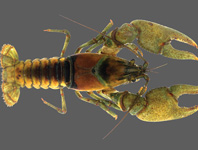Abstract
The status of Longior alius García & Coy, 1994 (Nematoda: Thelastomatoidea: Hystrignathidae) is discussed on the basis of new material obtained from its type host Antillanax pertyi (Kaup, 1869) (Coleoptera: Passalidae) from Limonar, Guantánamo province, Cuba, near the type locality. Based on morphological and molecular studies L. alius is considered synonymous with L. longior Morffe & García, 2011. L. longior and L. similis Morffe, García & Ventosa, 2009 are redescribed and illustrated with the aid of SEM. New locality records for both species are given. The conspecificity of females and males of both species is supported by comparison of the D2-D3 segment of the 28S LSU rDNA. The inter-specific differences and phylogenetic position of L. longior and L. similis are discussed.
References
Adams, B.J. (1998) Species concepts and the evolutionary paradigm in modem nematology. Journal of Nematology, 30, 1–21.
Capella-Gutiérrez, S., Silla-Martínez, J.M. & Gabaldón, T. (2009) trimAl: a tool for automated alignment trimming in large-scale phylogenetic analyses. Bioinformatics, 25, 1972–1973.
https://doi.org/10.1093/bioinformatics/btp348Coy, A. (1990) Nemátodos de la familia Hystrignathidae, parásitos de coleópteros (Passalidae) en Cuba. Poeyana, 402, 1–7.
Coy, A., García, N. & Álvarez, M. (1993) Nemátodos parásitos de insectos cubanos, Orthoptera (Blattidae y Blaberidae) y Coleoptera (Passalidae y Scarabaeidae). Acta Biológica Venezolana, 14, 53–67.
García, N. & Coy, A. (1994) Descripción de dos nuevas especies y registro de nuevos hospederos de nemátodos (Nematoda) de la región oriental de Cuba. Avicennia, 1, 13–17.
García, N., Ventosa, L. & Morffe, J. (2009a) Dos especies nuevas de los géneros Lepidonema y Longior (Thelastomatoidea: Hystrignathidae) de la Isla de la Juventud, Cuba. Solenodon, 8, 1–7.
García, N., Ventosa, L. & Morffe, J. (2009b) Especie nueva de Artigasia (Thelastomatoidea: Hystrignathidae) de Pico La Melba, Holguín, Cuba. Solenodon, 8, 8–11.
Hall, T.A. (1999) BioEdit: a user-friendly biological sequence alignment editor and analysis program for Windows 95/98/NT. Nucleic Acids Symposium Series, 41, 95–98.
Hunt, D.J. (1981) On Artigasia horridospina n.sp., Longior semialata n.sp., Mentecle magnifica n.sp., Paraxyo ensicrinatus n.sp. (Oxyurida: Hystrignathidae) and Pulchrocephala ? pulchrocephala Travassos, 1925 (Oxyurida: Pulchrocephalidae). Systematic Parasitology, 3, 33–52.
https://doi.org/10.1007/BF00012238Jex, A.R., Hu, M., Rose, H.A., Schneider, M.A., Cribb, T.H. & Gasser, R.B. (2006) Molecular characterization of Thelastomatoidea (Nematoda: Oxyurida) from cockroaches in Australia. Parasitology, 133, 123–129.
https://doi.org/ 10.1017/S0031182006009978Kumar, S., Stecher, G. & Tamura, K. (2016) MEGA7: Molecular Evolutionary Genetics Analysis Version 7.0 for Bigger Datasets. Molecular Biology and Evolution, 33, 1870–1874.
https://doi.org/10.1093/molbev/msw054Morffe, J. & García, N. (2010) Two new species of nematode (Oxyurida, Hystrignathidae) parasites of Passalus interstitialis Escholtz, 1829 (Coleoptera, Passalidae) from Cuba and a new locality for Longior similis Morffe, García & Ventosa, 2009. ZooKeys, 49, 1–11.
https://doi.org/10.3897/zookeys.49.402Morffe, J. & García, N. (2011) On some Cuban species of the genus Longior Travassos & Kloss, 1958 (Oxyurida, Hystrignathidae), with description of a new species. ZooKeys, 78, 1–14.
https://doi.org/10.3897/zookeys.78.958Morffe, J. & García, N. (2012) Una especie nueva de Longior Travassos et Kloss, 1958 (Oxyurida: Hystrignathidae) parásita de un pasálido (Coleoptera: Passalidae) de Panamá. Novitates Caribaea, 5, 73–80.
Morffe, J., García, N. & Ventosa, L. (2009) Longior similis sp. nov. (Thelastomatoidea: Hystrignathidae) parasite of Passalus interstitialis from western Cuba and new records of Longior zayasi. Solenodon, 8, 12–19.
Nadler, S.A., De Ley, P., Mundo-Ocampo, M., Smythe, A.B., Stock, S.P., Bumbarger, D., Adams, B.J., De Ley, I.T., Holovachov, O. & Baldwin, J.G. (2006) Phylogeny of Cephalobina (Nematoda): molecular evidence for recurrent evolution of probolae and incongruence with traditional classifications. Molecular Phylogenetics and Evolution, 40, 696–711.
https://doi.org/10.1016/j.ympev.2006.04.005Nunn, G.B. (1992) Nematode molecular evolution. Ph.D. University of Nottingham, Nottingham, 187 pp.
Rambaut, A., Suchard, M.A., Xie, W. & Drummond, A.J. (2003) Tracer v1.6. Available from: http://beast.bio.ed.ac.uk/Tracer (accessed 12 October 2016).
Ronquist, F., Teslenko, M., van der Mark, P., Ayres, D.L., Aaron, D., Höhna, S., Larget, B., Liu, L., Suchard, M.A. & Huelsenbeck, J.P. (2012) MrBayes 3.2: efficient Bayesian phylogenetic inference and model choice across a large model space. Systematic Biology, 61, 539–542.
https://doi.org/10.1093/sysbio/sys029Seinhorst, J.W. (1959) A rapid method for the transfer of nematodes from fixative to anhydrous glycerin. Nematologica, 4, 67–69.
https://doi.org/10.1163/187529259X00381Spiridonov, S.E. & Cribb, T.H. (2012) Travassosinema dalei sp. n. (Thelastomatoidea; Nematoda) from the hind gut of an Australian scarabaeid larva. New Zealand Journal of Zoology, 39, 291–300.
https://doi.org/10.1080/03014223.2012.668855Spiridonov, S.E. & Guzeeva, E.A. (2009) Phylogeny of nematodes of the superfamily Thelastomatoidea (Oxyurida) inferred from LSU rDNA sequence. Russian Journal of Nematology, 17, 127–134.
Travassos, L. & Kloss, G.R. (1958) Sobre a fauna de nematodeos dos coleopteros Passalidae da Estaçao Biologica de Boracéia. Arquivos de Zoologia, Sao Paulo, 11, 23–57.

